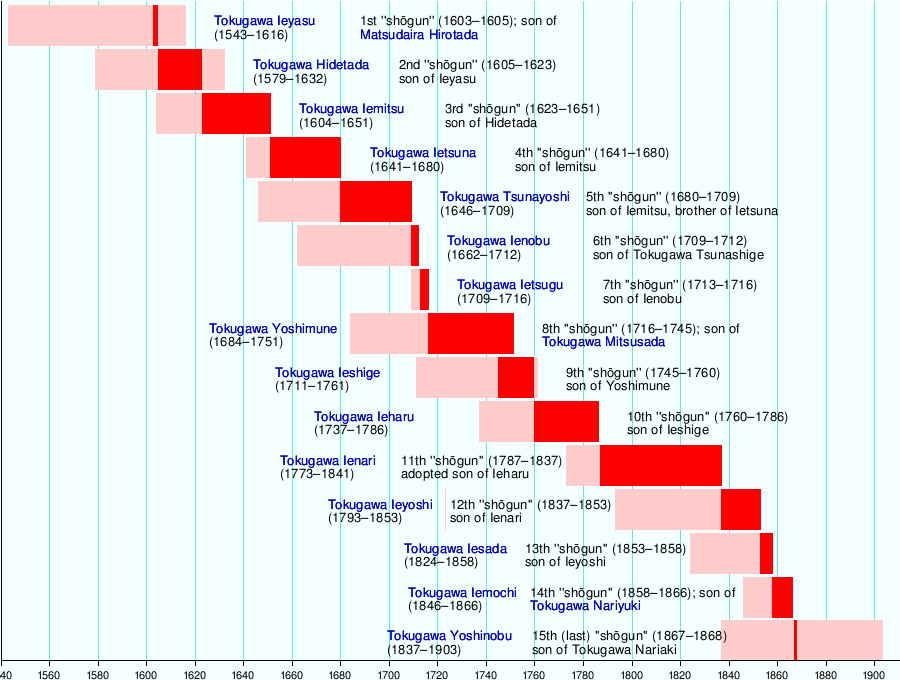Tokugawa Ieshige
Tokugawa Ieshige; 徳川 家重 (January 28, 1712 – July 13, 1761) was the ninth shōgun of the Tokugawa shogunate of Japan.
Tokugawa Ieshige | |
|---|---|
 | |
| Shōgun | |
| In office 1745–1760 | |
| Monarch | |
| Preceded by | Tokugawa Yoshimune |
| Succeeded by | Tokugawa Ieharu |
| Personal details | |
| Born | January 28, 1712 |
| Died | July 13, 1761 (aged 49) |
The first son of Tokugawa Yoshimune, his mother was the daughter of Ōkubo Tadanao, known as Osuma no kata. His mother died in 1713 when he was only 2 years old, so he was raised by Yoshimune's concubine, Okon no Kata but later Okon give birth to Tokugawa Munetake so he was raised by another of Yoshimune's concubines, Okume no Kata as her biological son.
His childhood name was Nagatomi-maru (長福丸). He underwent the genpuku coming-of-age ceremony in 1725. His first wife, Nami-no-miya, was the daughter of Prince Fushimi-no-miya Kuninaga (伏見宮 邦永親王). His second wife, Okō, was the daughter of one of the courtiers who had followed his high-born first wife from the Imperial Court to the Shogunal Court in Edo. This famously good-natured second wife was the mother of Ieharu, who would become Ieshige's heir.[1]
On April 16, 1731, he married Nami-no-Miya Masuko, daughter of Fushimi no Miya Kuninaga Shinnō.
In 1733, Nami-no-Miya Masuko had a miscarriage and died.
In Enkyō 2 or 1745, Ieshige was made shogun.[2]
Ieshige suffered from chronic ill health and a severe speech defect which rendered his speaking nearly incomprehensible.[3] Yoshimune's choice of Ieshige as his heir created considerable controversy within the shogunate as his younger brothers Tokugawa Munetake and Tokugawa Munetada appeared to be far more suitable candidates. Yoshimune continued to insist on his decision, favoring the Confucian principle of primogeniture; and Ieshige continued in the role of formal head of the shogunate. Yoshimune directed affairs after his official retirement in 1745. This attention was designed to ensure that Ieshige was secure in his office. Ieshige remained shogun until 1760.
Uninterested in government affairs, Ieshige left all decisions in the hands of his chamberlain, Ōoka Tadamitsu (1709–1760). He officially retired in 1760 and assumed the title of Ōgosho, appointed his first son Tokugawa Ieharu as the 10th shōgun, and died the following year.
Ieshige's second son Tokugawa Shigeyoshi became the founder of the Shimizu Tokugawa clan, which together with the Tayasu and Hitotsubashi (established by Ieshige's younger brothers) became the gosankyō, three cadet branches of the Tokugawa family from which future shoguns might be selected if the main line were to die out. They joined the existing three cadet branches, the gosanke, to which Ieshige's father Yoshimune had been born.
Ieshige's reign was beset by corruption, natural disasters, periods of famine and the emergence of the mercantile class, and his clumsiness in dealing with these issues greatly weakened the rule of Tokugawa.
Ieshige died in 1761. His posthumous title is Junshin-in; and his grave is at the Tokugawa family mausoleum at Zōjō-ji in Shiba. His remains were disinterred and underwent scientific investigation from 1958 to 1960. It was discovered that his teeth were crooked and badly deformed, confirming historical references to his speech defect.
Family
- Father: Tokugawa Yoshimune
- Mother: Osuma no Kata (1688–1713)
- Adopted Mother: Okume no Kata later Kakuju-in (1697–1777)
- Wife: Nami-no-Miya Masuko (1711–1733) later Somnyoin and buried in Kan'ei-ji
- Concubines:
- Oko no Kata later Shinshin'in (d. 1748)
- Oitsu no Kata (1721–1789) later Anshoin
- Oshizu no Kata
- Oyu no Kata (1721–1789) later Anjo-in
- Children:
- Tokugawa Ieharu born by Oko no Kata
- Tokugawa Shigeyoshi born by Oitsu no Kata
Eras during Ieshige's rule
The years in which Ieshige was shogun are more specifically identified by more than one era name or nengō.[2]
In popular media
Ieshige is a minor character in the anime series Mushibugyo, where he befriends the main character Jinbei Tsukishima.
Ieshige is a character in the live action series Nogaremono Orin broadcast in 21 episodes between October 26, 2006 and March 23, 2007 on TV Tokyo.[4]
A gender-swapped version of Ieshige appears beginning in Chapter 31 of Ōoku: The Inner Chambers.
Ancestry
| Ancestors of Tokugawa Ieshige | |||||||||||||||||||||||||||||||||||||||||||||||||||||||||||||||||||||||||||||||||||||||||||||||||||||||||||||||||||||||||||||||||||||||||||||||||||||||||||||||||||||||||||||||||||||||||||||||||||||||||||||||||||||||||||||||||||||||||||||||||||||||||||||||||||||||||||||||||||||||||||||||||||||||||||||||||||||||||||||||||||||||||||||||||||||||||||||||||||||||||||||||||||||||||||||||||||||||||||||||||||||||||||||||||||||||||||||||||||||||||||||||||||||||||||||||||||||||||||||||||||||||||||||||||||||||||||||||||||||||||||||||||||||||||||||
|---|---|---|---|---|---|---|---|---|---|---|---|---|---|---|---|---|---|---|---|---|---|---|---|---|---|---|---|---|---|---|---|---|---|---|---|---|---|---|---|---|---|---|---|---|---|---|---|---|---|---|---|---|---|---|---|---|---|---|---|---|---|---|---|---|---|---|---|---|---|---|---|---|---|---|---|---|---|---|---|---|---|---|---|---|---|---|---|---|---|---|---|---|---|---|---|---|---|---|---|---|---|---|---|---|---|---|---|---|---|---|---|---|---|---|---|---|---|---|---|---|---|---|---|---|---|---|---|---|---|---|---|---|---|---|---|---|---|---|---|---|---|---|---|---|---|---|---|---|---|---|---|---|---|---|---|---|---|---|---|---|---|---|---|---|---|---|---|---|---|---|---|---|---|---|---|---|---|---|---|---|---|---|---|---|---|---|---|---|---|---|---|---|---|---|---|---|---|---|---|---|---|---|---|---|---|---|---|---|---|---|---|---|---|---|---|---|---|---|---|---|---|---|---|---|---|---|---|---|---|---|---|---|---|---|---|---|---|---|---|---|---|---|---|---|---|---|---|---|---|---|---|---|---|---|---|---|---|---|---|---|---|---|---|---|---|---|---|---|---|---|---|---|---|---|---|---|---|---|---|---|---|---|---|---|---|---|---|---|---|---|---|---|---|---|---|---|---|---|---|---|---|---|---|---|---|---|---|---|---|---|---|---|---|---|---|---|---|---|---|---|---|---|---|---|---|---|---|---|---|---|---|---|---|---|---|---|---|---|---|---|---|---|---|---|---|---|---|---|---|---|---|---|---|---|---|---|---|---|---|---|---|---|---|---|---|---|---|---|---|---|---|---|---|---|---|---|---|---|---|---|---|---|---|---|---|---|---|---|---|---|---|---|---|---|---|---|---|---|---|---|---|---|---|---|---|---|---|---|---|---|---|---|---|---|---|---|---|---|---|---|---|---|---|---|---|---|---|---|---|---|---|---|---|---|---|---|---|---|---|---|---|---|---|---|---|---|---|---|---|---|---|---|---|---|---|---|---|---|---|---|---|---|---|---|---|---|---|---|---|---|---|---|---|---|---|---|---|---|---|---|---|---|---|---|---|---|---|---|---|---|---|---|---|---|---|---|---|---|---|---|---|---|---|---|---|---|---|---|---|---|---|---|---|---|---|---|---|---|---|---|---|---|---|---|---|---|---|---|---|---|---|---|---|---|---|---|---|---|---|---|---|
| |||||||||||||||||||||||||||||||||||||||||||||||||||||||||||||||||||||||||||||||||||||||||||||||||||||||||||||||||||||||||||||||||||||||||||||||||||||||||||||||||||||||||||||||||||||||||||||||||||||||||||||||||||||||||||||||||||||||||||||||||||||||||||||||||||||||||||||||||||||||||||||||||||||||||||||||||||||||||||||||||||||||||||||||||||||||||||||||||||||||||||||||||||||||||||||||||||||||||||||||||||||||||||||||||||||||||||||||||||||||||||||||||||||||||||||||||||||||||||||||||||||||||||||||||||||||||||||||||||||||||||||||||||||||||||||
Notes
- Screech, T. Secret Memoirs of the Shoguns: Isaac Titsingh and Japan, 1779–1822, p. 130.
- Titsingh, Isaac. (1834). Annales des empereurs du Japon, p. 418.
- Totman, Conrad (1967). Politics in the Tokugawa Bakufu. Harvard University Press. ISBN 9780674688001.
- 逃亡者 おりん:5年ぶりの続編が12年1月にスタート 青山倫子主演の時代劇. Mantan Web (in Japanese). 8 November 2011. Retrieved 20 February 2018.
- "Genealogy". Reichsarchiv (in Japanese). Retrieved 4 July 2018.
References
- Screech, Timon. (2006). Secret Memoirs of the Shoguns: Isaac Titsingh and Japan, 1779–1822. London: Routledge. ISBN 0-7007-1720-X
- Titsingh, Isaac. (1822). Illustrations of Japan. London: Ackerman.
- Titsingh, Isaac. (1834). [Siyun-sai Rin-siyo/Hayashi Gahō, 1652], Nipon o daï itsi ran; ou, Annales des empereurs du Japon. Paris: Oriental Translation Fund of Great Britain and Ireland.
- Totman, Conrad. (1967). Politics in the Tokugawa bakufu, 1600–1843. Cambridge: Harvard University Press.
External links
| Wikimedia Commons has media related to Tokugawa Ieshige. |
| Military offices | ||
|---|---|---|
| Preceded by Tokugawa Yoshimune |
Shōgun: Tokugawa Ieshige 1745–1760 |
Succeeded by Tokugawa Ieharu |
